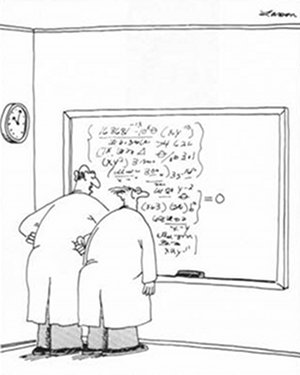The first evidence of zero is from the Sumerian culture in Mesopotamia, some 5,000 years ago.
There, a slanted double wedge was inserted between cuneiform symbols for numbers, written positionally,
to indicate the absence of a number in a place (as we would write 102, the 0
indicating no digit in the tens column).
The symbol changed over time as positional notation, for which zero was crucial, made its way to the Babylonian empire and from there to India, via the Greeks (in whose own culture zero made a late and only occasional appearance; the Romans had no trace of it at all).
Arab merchants brought the zero they found in India to the West, and after many adventures and much opposition, the symbol we use took hold and the concept flourished, as zero took on much more than a positional meaning and has played a crucial role in our mathematizing of the world.

No doubt about it Ellington -
we've mathematically expressed
the purpose of the universe. I love the
thrill of scientific discovery!
we've mathematically expressed
the purpose of the universe. I love the
thrill of scientific discovery!
The path that leads to the discovery of 0
lies only in the most advanced type of number
system, which is called positional
because the value of a character depends on its position. Our modern way of counting is positional.
The base figure 5
has a different value in 514 and in 145, determined by its position.
You come across a big stumbling block when you try to write a number like 2,002.
For a Roman, who used an additive numbering system, that is not a problem: MMII. But in a positional system, a way must be found to
indicate the absence of tens
and hundreds.
A gap could be left(the Babylonians did
this at first), but that opens the door to more scribal errors, and anyway how does one indicate two gaps, as in 2,002?
It becomes necessary to have a zero,
a character that signifies empty.
Maybe not necessary, because the brilliant Chinese mathematicians somehow managed to run a positional system without making
this discovery. The Babylonians (eventually), the Indians, and the Mayans did discover it, however.
But the next step, the true miracle moment, is to realize that the symbol for nothing
that is being used is not
just a place-holder, but an actual number: that empty
and nothing
are one. The null number is as real as 5
and 2,002
.
Without this, there is no modern mathematics, no algebra, no modern science.
